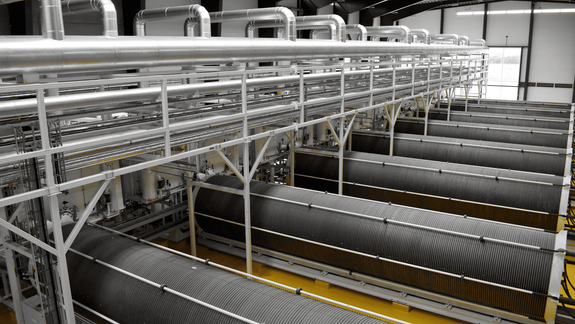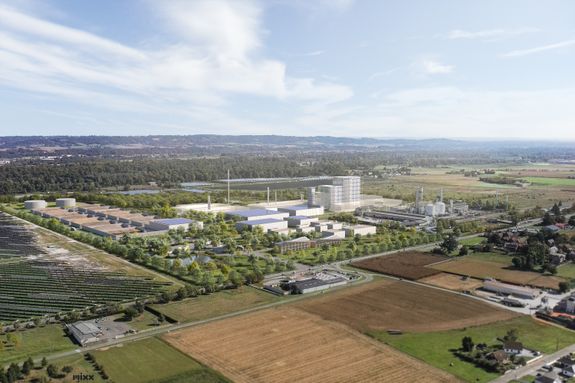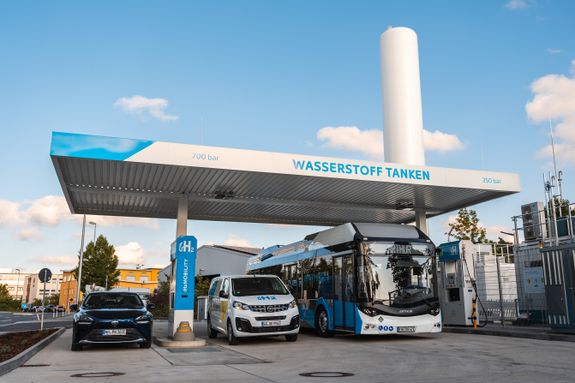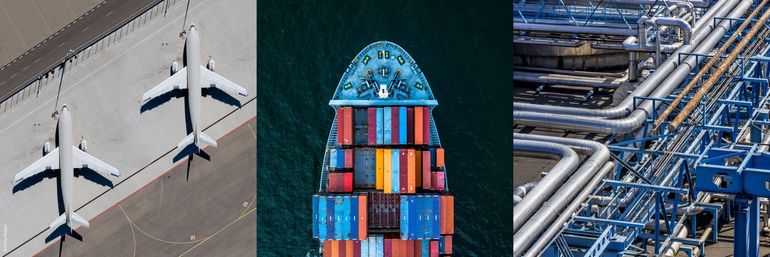What are the key hydrogen applications?
Most market forecasts predict hydrogen demand to exceed 500 million tonnes by 2050, representing five times today's level and equating to around 15% of the final energy demand. Hydrogen is seen as a replacement for fossil fuels in hard-to-abate industries (such as the chemical and petrochemical sectors, steel manufacturing, glass, and cement), intensive transport (aviation, maritime, rail, and intensive and heavy road transportation), as well as some niche power generation and heating applications.

As an energy vector (a medium for transporting energy across time and space), hydrogen and its derivatives (ammonia, methanol or LOHC) can be used for long-duration energy storage and as a medium for transporting low-cost renewable power from advantaged regions to consumption regions. We have chosen to present some of the main applications of hydrogen, based on investments made through our impact funds dedicated to infrastructure and critical hydrogen equipment.
Reducing the footprint of the steel industry
Along with cement, steel production generates the highest level of CO2 emissions of any industry. Roughly 2 tonnes of CO2 emissions are generated per tonne of steel produced via the integrated steel manufacturing processes. This steelmaking route represents roughly 8% of global emissions. There are two principal ways of making steel. Most steel today (1.2Mt from 1.8Mt) is based on primary production in blast furnaces where coking coal is widely used as a reducing agent in the furnaces to convert iron ore to pig iron. Hydrogen can be used to replace the primary blast furnace (BF/BOF) route with a mixed method consisting of Direct Reduction of Iron (DRI) and Electric Arc Furnace (EAF). In this method, specially produced iron ore pellets are converted to iron using hydrogen as a reduction agent, rather than coal, meaning that the carbon monoxide and carbon dioxide emissions are replaced with water vapor. Steel is further processed thereafter in an electric arc furnace using low-carbon power (renewables). In 2023, we invested to support Swedish company Stegra (through the “Clean H2 Infra Fund”) in their flagship project deployment of the world’s largest green steel plant in Boden (Sweden). This green plant will reduce emissions during steel production by 95%.

Decarbonizing the industrial existing usages
Today, roughly 90 million tonnes of fossil-based hydrogen are used as a feedstock in the petroleum chemicals sector for the desulfurization of oil products, in the production of ammonia and of methanol. The majority of hydrogen consumed worldwide is either produced from natural gas in steam methane reformers with a carbon footprint of around 9-11 kg/kg H2, or from coal in gasifiers where the footprint is roughly twice as large. As a result, fossil hydrogen production accounts for circa 3% of global CO2 emissions. In these industries, hydrogen is a chemical feedstock and cannot be substituted by renewable electricity. These industries represent a low-hanging fruit for the introduction of low-carbon hydrogen as its use is widely understood and already built into production processes. Oil companies are forming partnerships with green hydrogen producers to decarbonize their refineries. For example, Spain's Cepsa has entered into a partnership agreement with our portfolio company Enagas Renovable to address its green hydrogen needs (Hy24's infrastructure fund owns a 30% stake in Enagas Renovable). In 2023, we partnered with the Danish operator Everfuel through a joint venture (Hy24 Everfuel JV, under the “Clean H2 Infra Fund”) to support their portfolio deployment, particularly the HySynergy electrolyzer aimed at decarbonizing the nearby refinery.

Deploying sustainable aviation fuels (SAF) to serve the aviation sector
Air transport represents approximately 2-3% of global emissions. Sustainable Aviation Fuels (SAF) are one of the means the aviation industry is using to reduce that carbon footprint. Sustainable aviation fuels are produced with alternative sources to crude oil, which meet a sustainability criterion that depends on geographies and regulations. In Europe, the regulation (ReFuelEU aviation) requires a 70% reduction in greenhouse gases over the entire lifecycle compared to the fossil reference, while imposing constraints on eligible biomass sources to avoid usage conflicts and indirect emissions related to land use changes. There are two types of sustainable aviation fuels: biofuels produced from biomass, and synthetic fuels, also called e-fuels, produced from electrolytic hydrogen and recycled carbon. In 2022 and 2023, Hy24, through its Clean H2 Infra Fund, invested in Hy2gen and Elyse Energy. These two pioneering companies specialize in producing low-carbon molecules aimed at decarbonizing the aviation and maritime transport sectors.

Developing hydrogen for heavy and intensive mobility
Transport accounts for one third of global CO2 emissions. Hydrogen has the potential to help decarbonize all major mobility segments, particularly the longer-range applications involving heavier loads. Battery electric vehicles (“BEVs”) have gathered significant traction in the light-duty market thanks to falling battery costs, the potential to be recharged at every home with a driveway or garage and acceptable range. However, hydrogen Fuel Cell Electric Vehicles (“FCEVs”) have superior range and charging time — attributes that may prove popular with fleets such as emergency services or taxi operators as well as commercial vehicles which prioritise range and short refuelling times. A 700kWh battery electric heavy truck with 500-mile range takes over 3 hours to charge and has a battery payload of several tonnes whereas a similar range fuel cell truck can be refuelled in under 15 minutes and weighs the same as a conventional truck. Volvo/Daimler are targeting a 1,000-km range for their liquid hydrogen trucks. By the end of the decade, most truck makers will be offering a mix of BEV and FCEV models. Toyota, Hyundai and Hyzon are already providing such offerings on the market today.

Many countries have established decarbonization strategies aimed at banning internal combustion engine (ICE) cars, including the EU which has set this target for 2035. Major automakers have simultaneously committed to an unprecedented effort to adapt their industrial tools to decarbonize their vehicle range within the same timeline. As a result, passenger FCEV share of this segment could reach as high as 20% or more if all vehicles are required to be Zero Emission. Circa 15 countries now plan some sort of restrictions or bans on ICE buses and trucks from 2040 — a logical step considering the moves taken in the passenger car segment.
In 2022, we invested through our fund dedicated to infrastructures “Clean H2 Infra Fund”into German hydrogen stations operator H2 Mobility to expand further the existing network and build new stations to meet rising hydrogen demand for commercial and intensive use vehicles. In 2024, we became a major shareholder of French mobility player HysetCo (still through our infrastructure fund) to support the deployment of its integrated business offer of hydrogen infrastructures and fleets (mainly taxis).
Our investments
To date, we have made 9 investments to support Hy2Gen, H2 Mobility, Enagas Renovable, Everfuel, Elyse Energy, InterContinental Energy, H2 Green Steel, HysetCo and Hexagon Purus.






